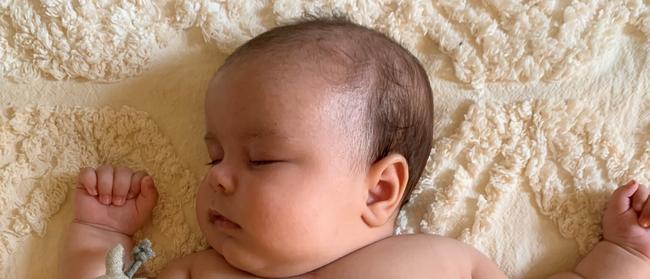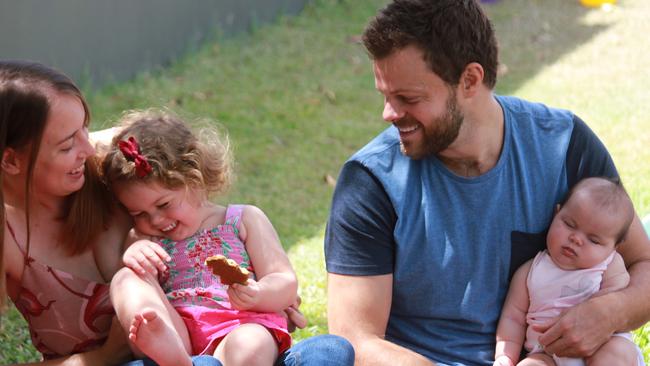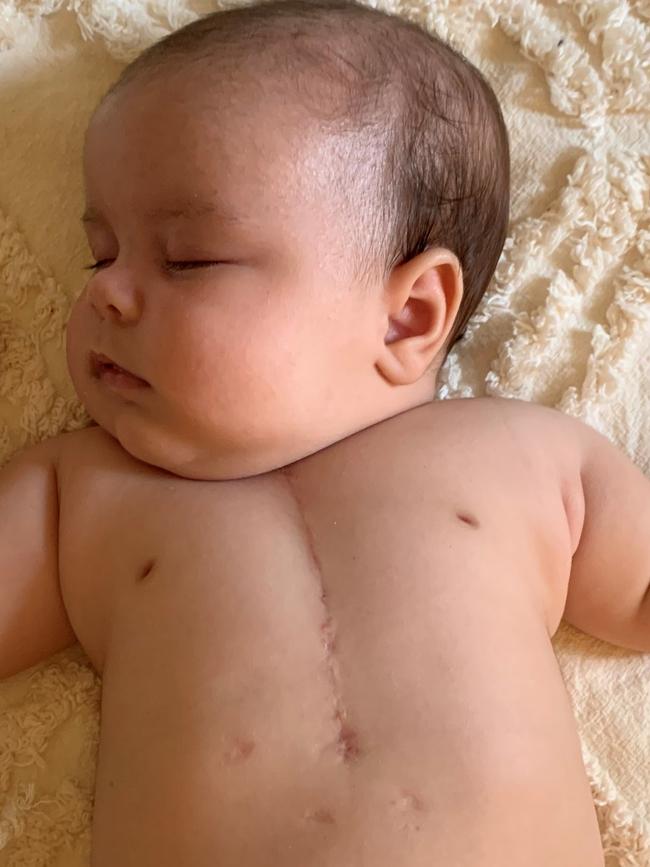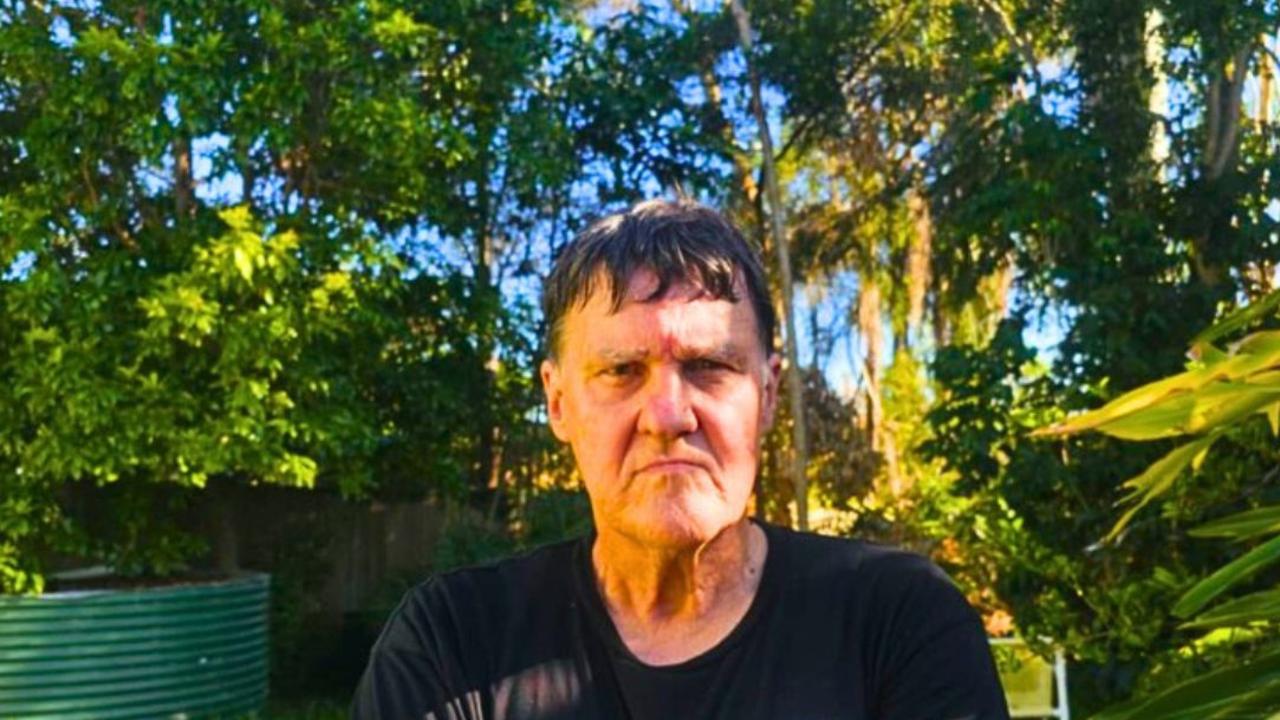A routine 20 week scan changed one Brisbane family’s world
A Brisbane couple felt their world fall apart at the routine 20 week scan for baby Emily. They share their story of dealing with Congenital Heart Disease and the charity that helped them through it.
North
Don't miss out on the headlines from North. Followed categories will be added to My News.
Before Emily Welch was born her tiny life clung to a naturally occurring pre-birth ‘hole’ in her heart.
Without the hole, which allowed oxygen to be transported throughout her body despite the arteries of her heart growing in the wrong position, Emily would have died.
Diagnosed with Transposition of the Great Arteries (TGA) at just 20 weeks gestation, the tiny baby’s chances of life became critical the moment she was born.
The pre-birth hole begins to close at birth, leaving doctors in a race against time to keep it open, using drugs, until they can carry out lifesaving open heart surgery.
For Kalinga couple Pascalle Plug and Terry Welch the idea that there could have been anything wrong with their baby never even entered their minds.
With no family history of cardiac conditions or even knowing anyone born with Congenital Heart Disease (CHD), the couple felt their world fall apart at the routine 20 week scan.
“We went in and they did the whole thing. We didn’t know if it was a boy or a girl. We weren’t planning on finding out. I think we just took it for granted we were going to have a healthy baby,” Ms Plug said.
“They did the ten fingers, ten toes and that normal nice stuff. Then it went on forever. He (the technician) was saying stand up, do some star jumps. At that stage Terry was thinking I’m running a bit late for work. And I thought this is completely different to Gabby.”
SUBSCRIBE TO CITY NORTH NEWS AND THE COURIER-MAIL AND GET A FITBIT

The couple’s first child Gabby was born almost two years earlier following a routine and healthy pregnancy.
“The appointment (for Emily) went for more than an hour and by then I thought that something was not right. Then he said just get yourselves sorted and come and we’ll have a bit of a chat.”
The chat, following several anxious minutes waiting for the technician to come back, changed the couple’s world. They went from a household with one healthy, vibrant toddler and looking forward to their second child to coming to terms with having a baby who could die.
CHD is one of the leading causes of deaths in babies in Australia for which there is currently no known cure.
“Essentially he said there is something wrong with your baby’s heart, which was the worst day of our lives.
He wasn’t a cardiac specialist and didn’t have a lot of information. He told us it was TGA and said I’m not the best person to explain that and told us to sit on it. They recommended not to Google because you get the worst of the worst but he gave us a drawing.”
“Basically she (Emily) needed an arterial switch to cut the arteries and put them back to the normal position.
At 4 weeks gestation it just didn’t go right.”
Sitting at Southbank following that first appointment the couple found themselves crying, questioning what the diagnosis meant for their unborn baby’s life.
“We didn’t know what it meant – what it meant her livelihood, if she was going to make it through the pregnancy,” Pascalle said.
“We had no idea of the extent of it. Which is why the HeartKids charity has been so good because before this we had no exposure to congenital heart disease especially in children.”
The couple have learnt the numbers and facts in the hardest way.
1 in 100 children are born with CHD and a further 1 per cent have TGA. In real terms it means approximately six babies are born in Australia every day with CHD.
“When Emily was born and was in the PICU (Paediatric Intensive Care Unit at the Queensland Children’s Hospital) there were 40 beds and 20 were cardiac beds for children of varying ages,” Mr Welch said.
“When I was growing up there was one kid I knew at school who had a heart condition.”

From the 20 week scan to Emily’s birth, surgeries and going home, the couple said without the support of medical staff and HeartKids the journey would have been so much harder.
Sitting down with the cardiac team, (after the initial scan) was the moment everything changed.
“They gave us all the information we could have possibly wanted. They said this case is simple. This is what happens. This is what the surgery might look like. We
do it often enough that there is confidence in it. There are risks. There may be further complications but at this point we can’t see any. At this point it looks like the standard arterial switch procedure,” Mr Welch said.
“We sat in that room and they gave us knowledge and they gave us HeartKids details. We were at that point almost grateful because there are really bad scenarios for babies and for us there was a procedure and they do it often enough and we were like – that’s a huge relief. We were a lot more comfortable.”
How hibernation saved Poppy-Rose
Redcliffe teen helps others with congenital heart disease
The aching fear of losing Emily became instead a journey to get her to surgery and to find their “own normal”.
“We walked out feeling almost lucky because in the congenital heart disease community there are some really poor families – four year old’s who have had seven surgeries. I just don’t know how they cope,” Ms Plug said.
Part of the coping she said comes with support from hospital staff, the paediatric cardiac specialists and HeartKids,
Ms Plug said although Emily’s journey had been tough “more than anything it makes you think how incredible it is when you have a child that doesn’t have one of these problems”.
At 10 days Emily underwent a number of medical procedures including open heart surgery to correct her heart defect.
A tangle of monitors and wires, Mr Welch said one of the difficult things was watching other families with children with far more serious conditions.
The couple, who have been supported by the national charity Heart Kids, supported calls for further research in the causes of and long-term needs of children diagnosed with congenital heart disease.
“Quite often people don’t talk about these things openly,” Mr Welch said.
“We had no idea of the extent of it which is why the Heart Kids charity has been so good because before this we had no exposure to congenital heart disease especially in children.
Heart Kids is the only charity dedicated to supporting families affected by CHD, they rely on fundraising to provide vital support and programs to help families like Emily, Gabby, Pascalle and Terry.

Heart Kids’ annual awareness and fundraising campaign – Show Your Heart – kicks off in February. To help or donate contact www.heartkids.org.au/showyourheart
A Heart Kids spokeswoman said during February the charity was aiming to raise $650,000 towards one-on-one support for parents with children undergoing heart surgery or going through treatment.
“With almost no government funding we can’t provide this without your help,” the spokeswoman said.
Congenital heart disease can include the following abnormalities:
- Aortic Valve Disease
- Atrial Septal Defect (ASD)
- Atrio-ventricular Septal Defect (AVSD)
- Coarctation of the Aorta
- Cyanotic Congenital Disease
- Mitral Valve Disease
- Persistent Ductus Arteriosus (PDA)
- Pulmonary Atresia
- Pulmonary Valve Disease
- Ventricular Septal Defect (VSD)
- Single Ventricle Pathology
- Tetralogy of Fallot (ToF)
- Transposition of the Great Arteries (TGA)
Source: HeartKids
HeartKids Purpose
HeartKids is the compass to help navigate the lifetime journey of the 64,000 Australian children, teens and adults affected by congenital heart disease. Our aim is to help them -and their families - to lead the most fulfilling life possible and to reach their personal goals.
We are the voice for all people impacted by congenital heart disease - the largest cause of infant death in Australia.
Our work is focused on our four pillars of Advocacy, Information, Research and Support.
Source: HeartKids.


